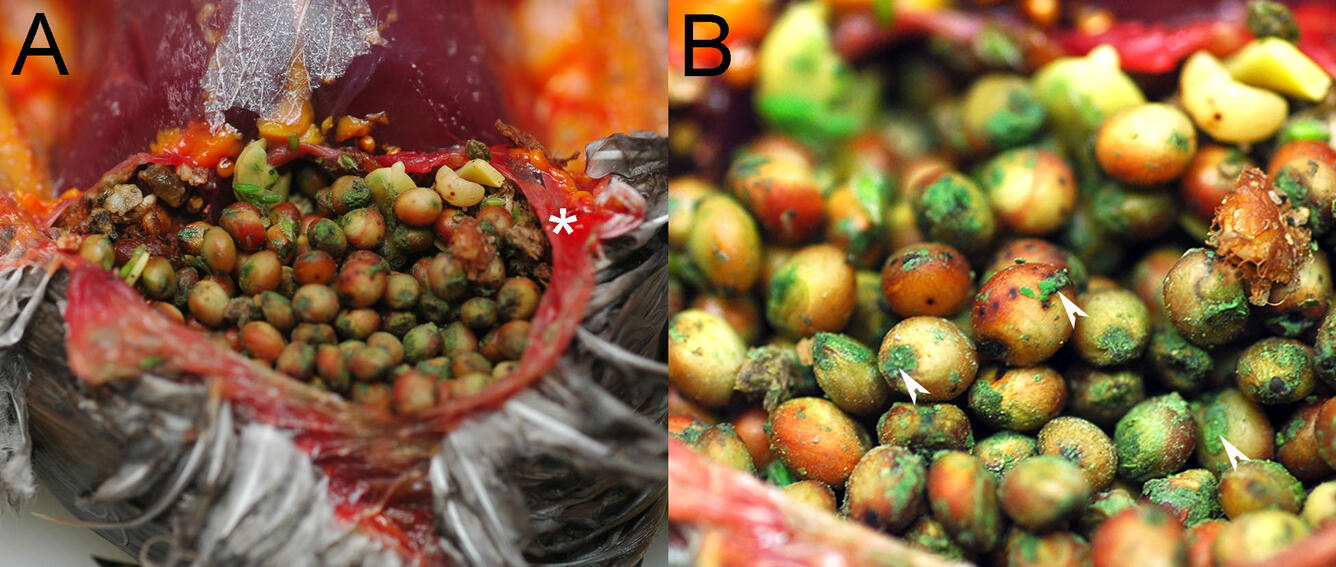Pathology Case of the Month - Mourning Dove
Case History: An immature female 122-g Mourning Dove (Zenaida macroura) was found dead in a park in Arizona, US. An estimated 18 birds including Inca Doves (Columbina inca), Great-tailed Grackles (Quiscalus mexicanus), and Mourning Doves were found dead with no reported clinical signs. Zinc phosphide was applied to ground squirrel burrows the day before the start of the mortality event.
Gross Findings: Lungs were pink, spongy and mildly wet. The proximal esophagus contained a few milo seeds. The crop was full and contained abundant milo seeds, a few corn fragments, several round ~1 mm in diameter round brown seeds, 4 x 3 mm brown seeds with a circumferential fringe and 2 whole sunflower seeds (Fig. 1A). A green coating was evident on the milo seeds (Fig. 1B). The mucosa of the crop was mildly reddened. The proventriculus was empty. The ventriculus contained a moderate amount of crushed seeds, mostly brown, and a small amount of grit. The liver, spleen and kidneys were moderately congested.
Laboratory Findings: Strychnine was identified in the upper gastrointestinal tract contents by gas chromatography-mass spectrometry (GC-MS) at Michigan State University’s Diagnostic Center for Population and Animal Health. Testing of upper gastrointestinal tract contents for phosphine, a byproduct of zinc phosphide, was negative.
Diagnosis: Strychnine Poisoning
Etiology: Strychnine (C21H22N2O2), an indole alkaloid used as a pesticide to control rats, moles, gophers and coyotes. Commercial baits are pelleted and often dyed red or green.
Distribution: Anywhere strychnine is sold.
Seasonality: Any season.
Host range: All species that have been tested were found to be sensitive to strychnine.
Transmission: Ingestion of bait in wildlife.
Toxicokinetics: Absorbed in small intestine, metabolized in liver, and excreted in urine. Highest concentrations found in blood, liver and kidneys.
Mechanism of action: Stimulates salivary and gastric secretions. Induces potent convulsions by competitive inhibition of glycine, an inhibitory neurotransmitter, resulting in unchecked stimulation of motor neurons affecting striated muscles. Stimulation of the extensor muscles results in generalized rigidity and tonic-clonic seizures. Death occurs due to respiratory failure.
Clinical signs: Poisoned birds are ataxic with ruffled feathers, wing droop, salivation, tremors and convulsions.
Pathology: Pinpoint pulmonary hemorrhages result from asphyxia. Rigor mortis occurs shortly after death and persists for days.
Diagnosis: A history of exposure or evidence of bait in the gastrointestinal tract. Clinical signs consistent with strychnine poisoning. Identification of strychnine by GC-MS in stomach contents, blood, urine, liver or kidney.
Public health concerns: Can be fatal in humans.
Wildlife population impacts: Can be fatal to wildlife due to inadvertent misuse or malicious intent.
Management: Use pesticides as labeled.
References:
Gupta RC. 2018. Non-anticoagulant rodenticides. In: Veterinary toxicology: basic and clinical principles, 3rd Ed., Gupta RC, editor. Academic press, London, United Kingdom, pp. 613–615.
Merck Veterinary Manual. 2016. Overview of strychnine poisoning, https://www.merckvetmanual.com/. Accessed July 2019.
U.S. Geological Survey. 1999. Field manual of wildlife diseases: general field procedures and diseases of birds, https://pubs.usgs.gov/itr/1999/field_manual_of_wildlife_diseases.pdf. Accessed July 2019.
Get Our News
These items are in the RSS feed format (Really Simple Syndication) based on categories such as topics, locations, and more. You can install and RSS reader browser extension, software, or use a third-party service to receive immediate news updates depending on the feed that you have added. If you click the feed links below, they may look strange because they are simply XML code. An RSS reader can easily read this code and push out a notification to you when something new is posted to our site.






